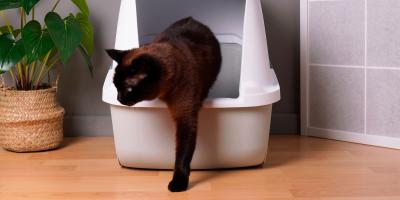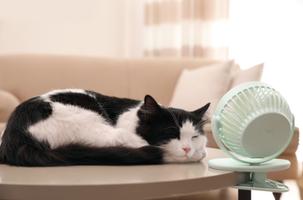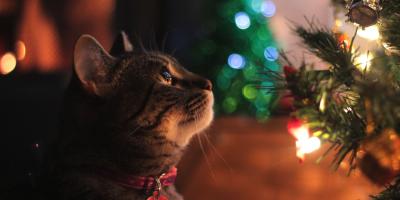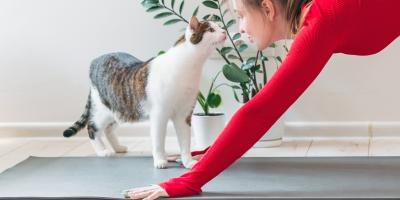
Domestic cats are often seen as cool, independent creatures who love basking in the sun. But when temperatures rise, you might wonder: Do cats sweat or overheat like humans? The answer is yes—cats do sweat, but not in the same way we do.
Most of a cat’s sweat glands are located in areas covered by fur, making them less effective for cooling. The exception? Their paw pads, which are one of the few places where sweat is visible.
In this guide, our experts explain how cats regulate their body temperature, why they might pant or sweat, and how you can help prevent overheating. We’ll also share practical tips to keep your cat cool and hydrated during the summer months.
Can Cats Sweat?
Can a cat sweat? Yes, cats perspire, but where do cats sweat from?Cats have eccrine sweat glands in hairless areas like their paw pads, lips, and noses. When your cat is hot, you might notice damp paw prints—a subtle sign they’re trying to cool down.
Unlike humans, cats don’t rely heavily on sweating. Instead, they use a combination of behaviors and biological mechanisms to stay cool:
- Grooming: When cats lick their fur, the saliva evaporates and helps lower their body temperature—similar to how sweat cools us.
- Seeking Cool Surfaces: Cats often lie on tile floors, sinks, or bathtubs to absorb the coolness.
- Shedding: Cats often shed more than usual when it’s hot outside. Brushing your cat can help with that process and provide some bonding with your cat
- Panting: Though rare, cats may pant when overheated. This allows heat to escape through evaporated moisture in their mouths.
How Cats Sweat and Where Cat Sweat Comes From
How do cats sweat? Since cats sweat through their paws, if they leave damp footprints behind, that’s how you’d know they’re hot.
Do cats have sweat glands? Yes. To regulate body temperature, they sweat through their paws, which includes their eccrine glands.
Cat Eccrine Glands
How do cats sweat through their paws? The eccrine sweat glands are in hairless areas of cats, such as their paw pads, between their toes, lips, and noses.
Why Do Cats Sweat and Pant?
But then you might ask yourself, Why is my cat sweating AND panting?
Suppose you find yourself in this situation, wondering, Why do cats pant? In that case, your cat might suffer from heat exhaustion or heatstroke. Cats typically don’t pant as dogs do.
Cat Heat Exhaustion or Heatstroke
What temperatures are cats comfortable in? Cats may be comfortable in temperatures up to 100 degrees Fahrenheit. Usually, what is a normal cat temperature for their body is about 101 degrees. At 104 degrees, a cat may suffer from heatstroke. Signs of cat overheating may include:
- A cat sweating excessively
- Panting
- Disorientation
- Seizures
- Shaking
- Excessive drooling
- Diarrhea
- Vomiting
- Bright red tongue, gums, or other parts of the mouth
If you notice your cat showing any of these signs, immediately move them to a cooler environment and call your veterinarian.
Anxious Sweating for Cats
Do cats sweat when stressed? Yes—cats can sweat and pant due to anxiety, it has encountered a severe stressor. Stressful situations like travel, loud noises, or unfamiliar environments can trigger these responses. If panting continues after the stressor is removed, seek veterinary care right away.
How to Reduce Cat Sweating and Prevent Overheating
While cats are less prone to heatstroke than dogs, they’re still at risk—especially in the following situations:
- Jumping into a clothes washer or dryer and getting trapped
- Exploring an outdoor shed without air conditioning, and the door closes behind them
- A stray or runaway cat finding themselves without shade or water
- Bringing a cat in the car for a veterinary checkup, and then the cat is left in the car for a “quick” errand
- Never leave your cat in a car
If your cat’s paws are already wet, you must take the proper steps to prevent overheating.
- First, for optimal prevention, it’s best to shepherd them out of the heat, if possible
- That means in a well-ventilated, climate-controlled environment
- Allow them ample shade and help them avoid hot pavement
- Wet the cat’s fur if you can get a damp, cold cloth
- Give them cool water to drink. It wouldn’t hurt to add an ice cube if available. Hydration is key
Cat Hydration
Hydration is key to preventing overheating. Offer your cat fresh water to drink. Wet cat food can also provide extra hydration. If your cat is being picky about drinking the water it needs to avoid overheating, try giving them the easy-to-feed Hydra Care supplement by Purina Pro Plan Veterinary Supplements, which has been shown to promote hydration in cats.
If your cat is dehydrated, signs may include:
- Elevated heart rate
- Skin tenting
- “Skin tenting” is a phrase for decreased skin elasticity in cats. Try gently pinching your cat’s skin over its shoulders and releasing it. If it stays in place, your cat is dehydrated.
- Dry gums
- Lethargy
- Depression
- Loss of appetite
Any of the above signs warrant an immediate call to your veterinarian. They can help your cat recover from overheating.
The following cats are more likely to experience overheating or heatstroke compared to other cats:
- Nursing and pregnant cats
- Senior or young cats
- Cats suffering from pre-existing conditions such as heart or lung disease
- Obese cats
- Brachycephalic cat breeds, such as:
How to Keep Outdoor Cats Cool in the Summer
If you care for outdoor cats, help them beat the heat by:
- Providing constant access to clean, cool water
- Creating shaded rest areas
- Checking sheds and garages before closing doors
- Letting them play with ice cubes for enrichment and cooling
For more expert tips on cat skin, explore our other cat health articles.
Related articles




